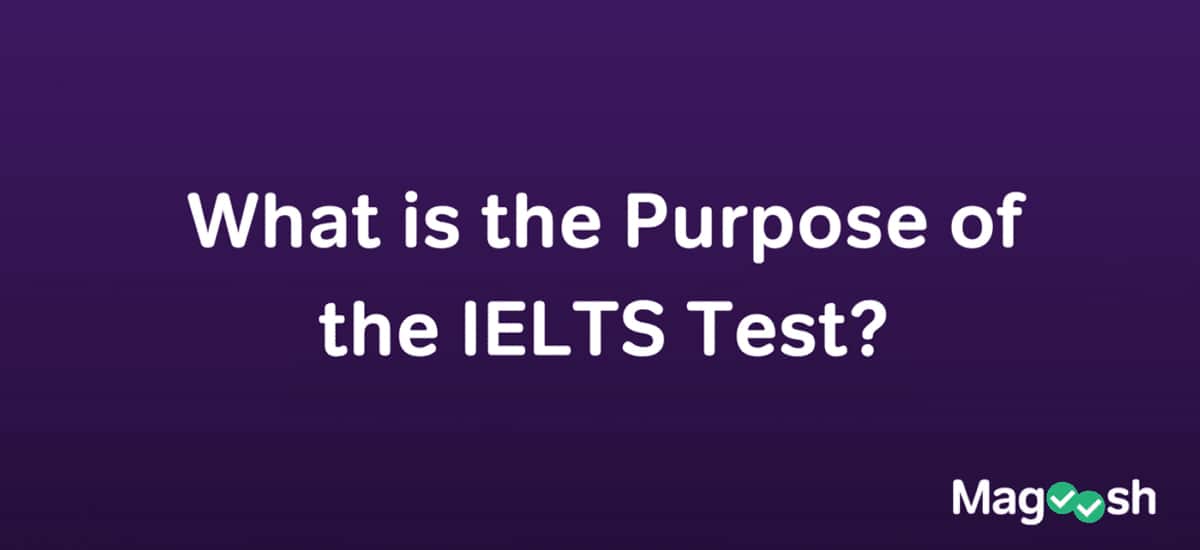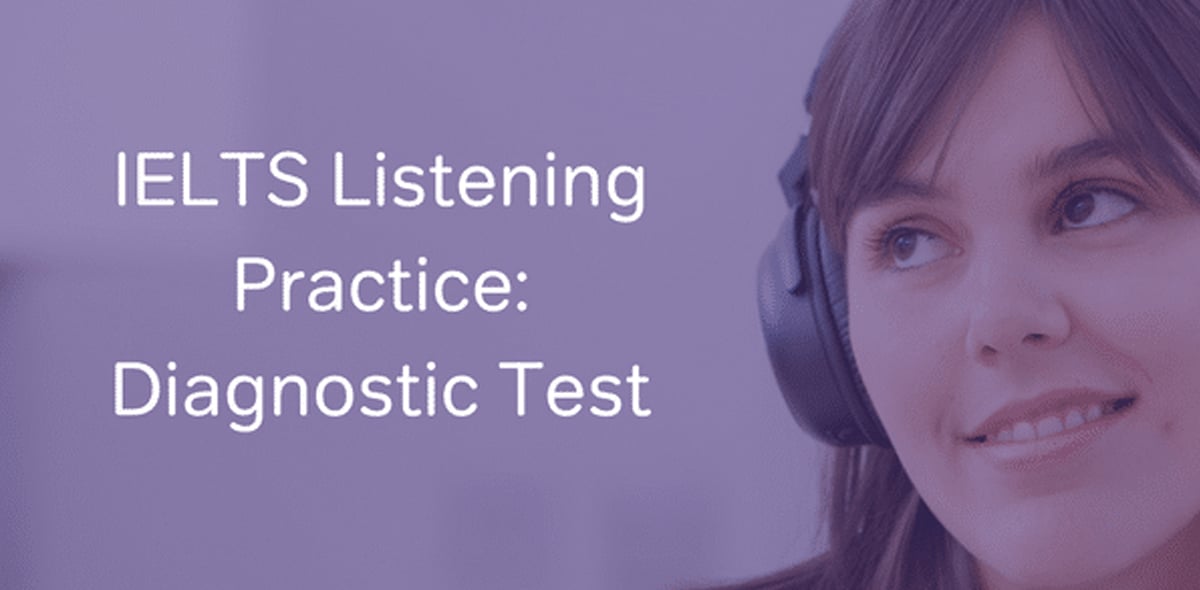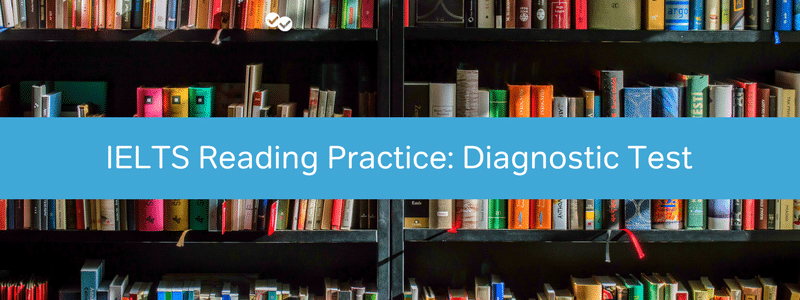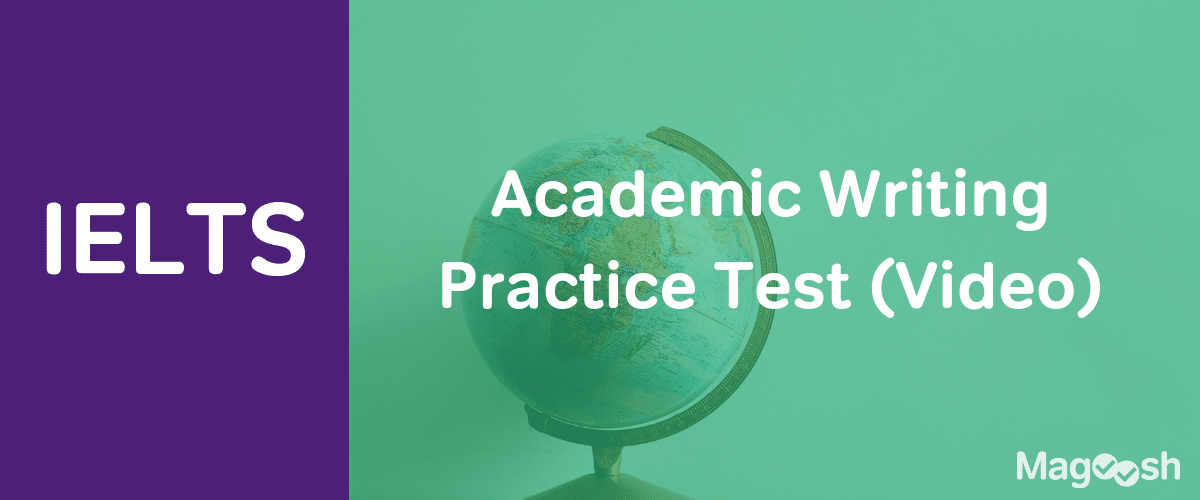What is IELTS, and what is the purpose of this exam? IELTS stands for “International English Language Testing System.” This test assesses the English ability of non-native English speakers. In this post, we’ll look at the IELTS exam format, the skills the IELTS assesses, and the way that IELTS scores are used. Once you’ve learned all about IELTS meaning and purpose, you’ll find answers to frequently asked questions about the IELTS, so that you can know how to take and pass this test!

Table of Contents
- What is the IELTS test for?
- What does the IELTS exam consist of?
- IELTS Listening Test Format
- IELTS Reading Test Format
- IELTS Writing Test Format
- IELTS Speaking Test Format
- What is the difference between IELTS Academic and General Training?
- How similar are IELTS Academic and IELTS General Training?
- How different are IELTS Academic and IELTS General Training?
- FAQ about the IELTS Exam
What is the IELTS test for? (General Information about IELTS Meaning)
The IELTS is used for the purposes of study, employment, and immigration in the English-speaking world. To learn more, check out our video below:
Compared to other Cambridge English exams, the IELTS is much more useful for immigration or acceptance into university. Cambridge exams such as the PET, FCE, and BULATS are used almost exclusively for employment at private companies, rather than the formal granting of medical licenses, skilled migrant visas, and acceptance into degree programmes.
What does the IELTS exam consist of?
Audio tracks, passages, essays, and interviews, oh my! At a glance, the IELTS test has four sections: IELTS Listening, IELTS Reading, IELTS Writing, and IELTS Speaking. These four sections are found on two different versions of the exam: IELTS Academic and IELTS General Training. If you’re wondering, “What is IELTS test content like?” we’ll take a look at the format of these four sections in more detail below.
The IELTS assesses four English skills. There are assessments for the “literacy” English skills, reading and writing. And the IELTS also tests your ability in listening and speaking, the conversational English skills. The IELTS tests your English skills with a variety of question types and task types. You’ll need to answer multiple choice questions in various formats. There are also short answer questions, where you must write in the correct word or phrase. And there are tasks where you will talk to a native or near-native English speaker and write essays or letters in English.
Because there are so many different types of test items, the IELTS is not just a language test. It’s also an assessment of your test-taking skills.
When someone asks, “How’s your English?” a common way to answer involves highlighting your strengths and weaknesses on the IELTS test. In other words, look at your IELTS practice test performance, and figure out what you’re good and not-so-good at. Why? Because each language user has a unique combination of strengths and weaknesses.
IELTS Listening Test Format
Your listening skills will be tested, logically, as you demonstrate your ability to understand the speech of native English speakers in this 40-minute exam. Each recording represents a different kind of speech: everyday conversation, monologues that occur in an everyday context (e.g. information), conversations in training/classroom settings, and formal monologues, like course lectures.
What is IELTS exam content like for the listening test?
Each recording has corresponding questions, 40 in total. They may be:
- multiple choice
- sentence completion
- matching
- plan/map/diagram labelling
- form/note/table/flow-chart/summary completion
Skills Tested
What is IELTS testing you on when it comes to listening? IELTS Listening is exactly the same in Academic and in General Training. So it makes sense that this section tests a mixture of academic and “life skills” listening. You’ll be expected to understand conversations and monologues related to business, school, and personal life. That’s the short answer; for more information, read our Complete Guide to IELTS Listening, and find your baseline score with a free IELTS Listening diagnostic quiz.
IELTS Reading Test Format
The reading section also requires you to correctly answer 40 questions, but this time, you’ll demonstrate your reading comprehension.
What is IELTS exam content like for the reading test?
The text types and passage lengths differ for the two versions of the test, but both have the same possible question formats, including:
- multiple choice
- matching
- sentence completion
- summary/note/table/flow-chart completion
- diagram label completion
- short-answer questions
What is IELTS test content like for Academic vs. General Training Reading?
What does IELTS Academic Reading cover? If you’re taking the academic version, you’ll read three passages. Each passage will be followed by questions of varied formats.
Now, what is IELTS General Training Reading like? The General Training version of the reading test has three sections. The first includes multiple short texts, the second includes two slightly longer texts, and the third has a single long text. Question types, of course, will vary.
Skills Tested
In IELTS Academic, you are largely being tested on your ability to comprehend academic and educational passages. General Training has more of a mix of skills. Academic reading ability is also assessed in IELTS General Training. But GT Reading also tests “life reading,” the ability to read bulletins about things like shopping and travel, and the ability to read work documents. Learn more in our Complete Guide to IELTS Reading, and find your baseline score in this free IELTS Reading diagnostic quiz.
IELTS Writing Test Format
What is IELTS exam formatting like for the writing test? The writing portion also varies depending on which version of the test you’re taking. In either case, you will have 60 minutes to complete two writing tasks.
What is IELTS test content like for Academic vs. General Training Writing?
What is IELTS test writing like in Academic? In this version, you’ll be required to show that you can provide a written description of some visual information (no less than 150 words in 20 minutes) and that you can develop your ideas in an essay about a specified topic (no less than 250 words in 40 minutes). Both should demonstrate your ability to use English in an academic or semi-formal tone. For more information, check out our guides to Academic Writing Task 1 and Task 2.
And what is IELTS test writing like for General Training? The first writing task involves a familiar task, like letter writing, in response to a scenario. You will be given 20 minutes to write about 150 words. The second task is an essay and should be no less than 250 words. You will be given specific instructions on what to discuss and you will have 40 minutes to do so.
Skills Tested
Again, the focus of IELTS Academic Writing is purely, well, academic. IELTS Academic Writing tests your ability to write a short source-based academic essay (the source is the graph or table). IELTS Academic also tests your ability to write an academic-style opinion essay. This opinion essay writing ability is also found on the IELTS GT. But in addition, the GT tests writing as a life skill by asking you to write a letter to a friend or colleague. You can find your baseline Writing score using an IELTS Writing diagnostic quiz.
IELTS Speaking Test Format
The Speaking test lasts only 11-15 minutes and is broken down into three sections:
- Part One involves a general introduction during which you are verbally asked questions that invite you to share a little bit about your life.
- Part Two requires that you speak on a topic in what is called “the long turn.” What is IELTS test Speaking long turn like, in terms of topics and structure? The topic is given to you in written form. You will be allowed to make and use notes so that your thoughts are organised before you speak.
- Part Three involves a discussion in which the examiner will ask several questions to allow you to explore the same topic in a bit deeper or more broadly together.
For ideas about the topics that will be discussed, read the Magoosh IELTS Speaking Topics PDF.
Skills Tested
For the most part, IELTS Speaking is focused on life skills. The interview focuses on light personal conversation. This is the kind of talk you’ll have with many different people when you work or study in the English speaking world. However, there is also an academic component here. The “long turn” in Part 2 is similar to the kind of short speech you might give in a university communications course. Learn more about your baseline score in this free IELTS Speaking diagnostic quiz.
What is the difference between IELTS Academic and General Training?
Obviously, IELTS Academic and IELTS General Training have slightly different purposes, so the IELTS meaning of these exams may vary. This is not just true for the skills these tests assess. The scores for these two versions of the IELTS are also used in different ways. Continue reading for a brief overview, or learn more about the two tests in Academic and General Training Versions of the IELTS: What’s the Difference?
IELTS Academic vs. IELTS General Training: Similarities
The two different types of IELTS are more similar than they are different. They each have the same very basic format. There are Listening and Reading sections with 40 questions each and 60 minutes each, a Writing section with two tasks, and an IELTS Speaking interview. Not only that, but as you've seen above, the Listening and Speaking tests are exactly the same in Academic and GT.
But how similar are these two exams, really? Well, if you want to measure it, you can say that IELTS Academic and IELTS GT are roughly 70% alike. By this I mean that 70% of the content will be exactly the same on both exams.
In addition to the identical Listening and Speaking sections, these two versions of the IELTS have Writing sections that are half the same; Task 2 is the same on Academic and GT. You can also say that IELTS Academic Reading and IELTS GT Reading are 1/3 the same. There are three academic passages of equal length in IELTS Academic; IELTS GT has one such passage.
IELTS Academic vs. IELTS General Training: Differences
So we know that the two exams are a lot alike, with a closer IELTS meaning than you might expect. But those little differences in content can make a huge difference in in how you study for the exam. And of course, those little differences make a big difference when it comes to where your scores will go, and how they will be analysed.
As I explained in the section on IELTS test format, all of the differences lie in IELTS Reading and IELTS Writing. The IELTS General Training Reading passages are shorter on average. The passages are also more varied, covering more “work and living” subject matter. And in Writing, the first GT task is far less academic; you write a letter instead of summarising a scholarly source.
How Can I Prepare for the IELTS Exam? And Other Frequently Asked Questions About the IELTS
By this point, you should know the answer to “What is IELTS?” Now it’s time to get studying! As you begin your IELTS prep, it helps to know a few other things about the IELTS, beyond its purpose. Below are some common questions about the IELTS, with answers.
Why is the IELTS exam required?
Schools and businesses require the IELTS exam so that they know you will have a basic understanding of English before they meet you. For an overview, see our article, Why is the IELTS Exam Required?
How can I take the IELTS exam?
Register and sit! To take the IELTS, you need to find your nearest IELTS test location and register for the exam. For more information on registry, see our guide to IELTS registration and test dates.
What is IELTS exam pricing like? How much does the IELTS cost?
For so many budget-conscious test-takers, this is such an important question. This ties into IELTS meaning in a financial sense, doesn’t it? IELTS fees range from about $150 to $300 USD. The cost of registering for the IELTS depends on the location of the IELTS test centre. Every country has its own price ranges. And the various organisations that host the IELTS exam have their own prices. For details on IELTS costs (and how to find the best prices), see the Magoosh guide to IELTS fees.
Who offers the IELTS?
What is IELTS test availability, in terms of the companies that offer it? The IELTS is officially sponsored by three organisations: Cambridge, the British Council, and IDP Education.
Of these three official IELTS sponsors, the British Council and IDP offer IELTS testing at test centres they administer. The IELTS is also administered by a wide variety of other international and regional agencies, such as AMIDEAST and the Anglo Mexican Foundation. To find out who offers the IELTS near you, use the official “Find a Test Location” search engine on IELTS.org.
Where can you take the IELTS?
What is IELTS test availability, you ask? The IELTS is available in more than 140 countries. For a complete list of the countries that offer the IELTS right now, see Magoosh’s article on where to take the IELTS.
For exact locations within a country or city, you’ll again want to refer to the IELTS’s “Find a Test Location” service.
When should you take the IELTS?
What is IELTS test scheduling supposed to be like? There are several things you should think about when you schedule your IELTS, such as application deadlines, study timelines, possible retakes, available test dates, etc…. To help you with this important decision, check out this “guide to choosing your IELTS test dates” If you’re still not sure after reading that, see Magoosh’s in-depth guide to choosing Your IELTS test date.
What is IELTS exam testing like? Is the IELTS test paper-based?
Although the computer-delivered IELTS is becoming more widely available, the IELTS is still paper-based for most test-takers. So let’s talk about how your written answers will work if you are one of the many students taking the traditional paper version of the test. For IELTS Reading, you’ll enter your answers directly into the test booklet. For IELTS Listening, you’ll write your answers as you listen. At the end, you’ll transfer your answers to an answer sheet. Finally, you’ll hand-write your essays in IELTS Writing.
This says something important about the purpose of the paper-based IELTS: this version of the IELTS does not test computer literacy. But it does test handwriting. Be sure to practice good penmanship. And for those who are a little uncomfortable forming English letters by hand, the IELTS offers a “cheat” of sorts. In IELTS Reading and Listening, you are allowed to write short answers in all CAPITAL letters. Your essays in IELTS Writing, however, will need to follow standard English rules for capitalization, so the shortcut only applies to Reading and Listening. For more info on all this, you can check out our article on IELTS handwriting rules, tips, and tricks.
What are alternatives to the IELTS exam?
Most English language university programmes that accept IELTS Academic will also accept alternative English assessments. Usually, the TOEFL is offered as an alternative university entrance exam. But there can be other options too. If you want to explore different testing options, contact your school to see if they accept any IELTS alternatives.
In the United States, government agencies also use the TOEFL for skilled migrant visas and licensure for healthcare professionals. Because the IELTS Academic exam is more similar to the TOEFL than IELTS General Training, sometimes the IELTS Academic exam is used to assess the English abilities of foreign workers in America. The TOEFL is sometimes used as an IELTS substitute for medical professionals outside of the US, too. Check with immigration offices or employment agencies if you are curious about TOEFL vs. IELTS for medical work.
For General Training, alternative testing may also be possible. Australia accepts both TOEFL and IELTS for immigration. Other Commonwealth nations do not accept TOEFL for immigration. But they may have their own local alternatives to the IELTS. Canadian Immigration, for example, also accepts scores from the Canadian English Language Proficiency Index Program (CELPIP).
How is the IELTS different from the TOEFL?
The biggest difference between the IELTS and the TOEFL is that the TOEFL is usually administered by computer, while the IELTS is usually administered on paper. (However, the TOEFL PBT (paper-based-test) is an option in some parts of the world.)
There are plenty of other differences too. The TOEFL, for example, comes in academic format only, with no general training version. Also, there are fewer types of TOEFL Reading and Listening questions. And the TOEFL Speaking section asks students to read passages, listen to audio, and record short speeches. In contrast, the IELTS Speaking section is an interview with a live person. Remember too that the TOEFL Writing Task 1 is significantly different than Task 1 in Academic or GT IELTS Writing.
Often, you’ll be given a choice between taking the IELTS or taking the TOEFL. So you want to consider the differences carefully. For help with this, see a comparison of the IELTS and TOEFL, and read our guide to TOEFL vs. IELTS over at the Magoosh TOEFL Blog.
How can I prepare for the IELTS exam?
Good IELTS prep is key here. You can find great prep materials through the links below.
- Magoosh IELTS prep
- Free IELTS diagnostic tests for Listening, Speaking, Writing, and Reading
- List of the best IELTS books and resources
- free IELTS study guide
- One week IELTS study schedule
- One month IELTS study schedule
- Preparing for the IELTS in one month (using only free materials!)
- IELTS Test Day Checklist
What is a good IELTS score? What is IELTS exam scoring like?
It all depends. Every organisation that uses IELTS scores sets its own requirements. As a result, there are many different good IELTS scores. Is your score good enough? That all depends on who is using your scores, and the purpose of your IELTS scores. For a full guide to good IELTS scores and how they’re calculated, see What is a Good IELTS Score?
Editor’s Note: This “What is IELTS?” post was updated for freshness and accuracy in August 2017. Trisha Alcisto made significant contributions to this new, improved guide to IELTS meaning.





